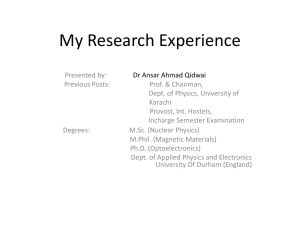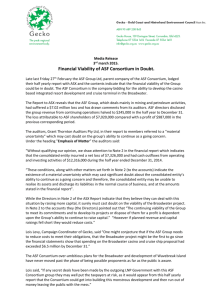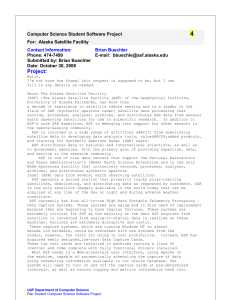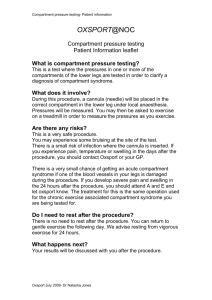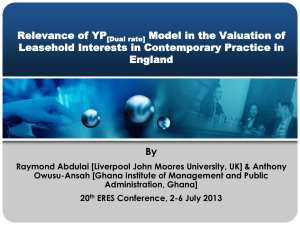Word file (120 KB )
advertisement
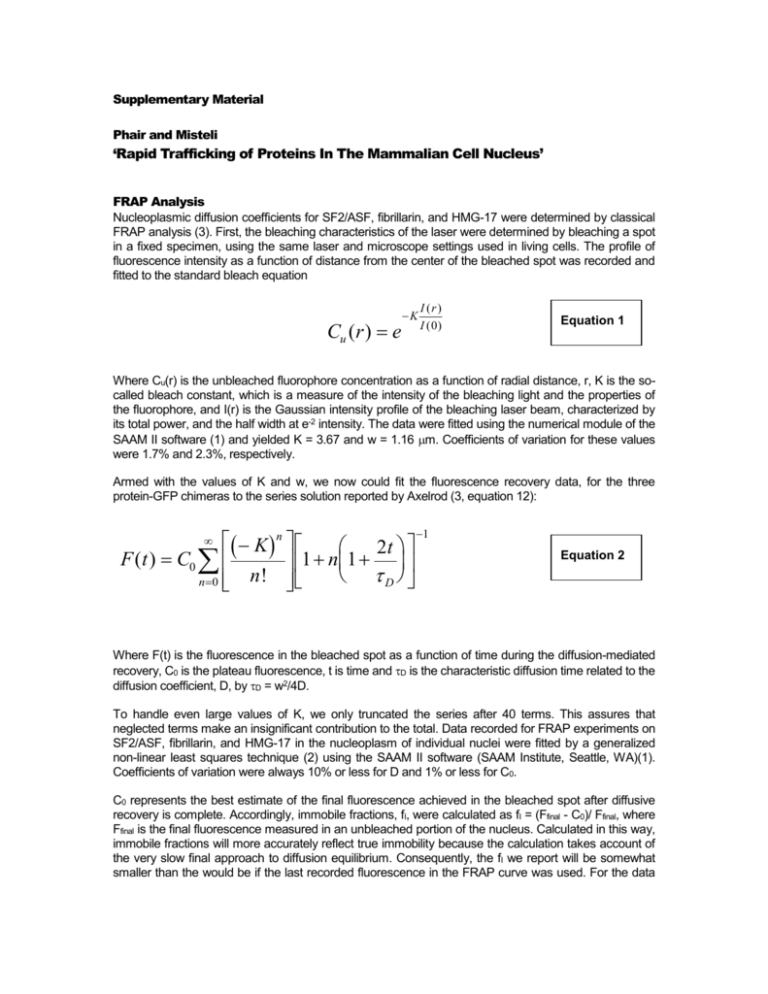
Supplementary Material Phair and Misteli ‘Rapid Trafficking of Proteins In The Mammalian Cell Nucleus’ FRAP Analysis Nucleoplasmic diffusion coefficients for SF2/ASF, fibrillarin, and HMG-17 were determined by classical FRAP analysis (3). First, the bleaching characteristics of the laser were determined by bleaching a spot in a fixed specimen, using the same laser and microscope settings used in living cells. The profile of fluorescence intensity as a function of distance from the center of the bleached spot was recorded and fitted to the standard bleach equation Cu (r ) e K I (r ) I ( 0) Equation 1 Where Cu(r) is the unbleached fluorophore concentration as a function of radial distance, r, K is the socalled bleach constant, which is a measure of the intensity of the bleaching light and the properties of the fluorophore, and I(r) is the Gaussian intensity profile of the bleaching laser beam, characterized by its total power, and the half width at e-2 intensity. The data were fitted using the numerical module of the SAAM II software (1) and yielded K = 3.67 and w = 1.16 m. Coefficients of variation for these values were 1.7% and 2.3%, respectively. Armed with the values of K and w, we now could fit the fluorescence recovery data, for the three protein-GFP chimeras to the series solution reported by Axelrod (3, equation 12): K n 2t F (t ) C0 1 n 1 n ! n0 D 1 Equation 2 Where F(t) is the fluorescence in the bleached spot as a function of time during the diffusion-mediated recovery, C0 is the plateau fluorescence, t is time and D is the characteristic diffusion time related to the diffusion coefficient, D, by D = w2/4D. To handle even large values of K, we only truncated the series after 40 terms. This assures that neglected terms make an insignificant contribution to the total. Data recorded for FRAP experiments on SF2/ASF, fibrillarin, and HMG-17 in the nucleoplasm of individual nuclei were fitted by a generalized non-linear least squares technique (2) using the SAAM II software (SAAM Institute, Seattle, WA)(1). Coefficients of variation were always 10% or less for D and 1% or less for C0. C0 represents the best estimate of the final fluorescence achieved in the bleached spot after diffusive recovery is complete. Accordingly, immobile fractions, fI, were calculated as fI = (Ffinal - C0)/ Ffinal, where Ffinal is the final fluorescence measured in an unbleached portion of the nucleus. Calculated in this way, immobile fractions will more accurately reflect true immobility because the calculation takes account of the very slow final approach to diffusion equilibrium. Consequently, the fI we report will be somewhat smaller than the would be if the last recorded fluorescence in the FRAP curve was used. For the data reported here, in which recovery is nearly complete during the observation period, this difference is small. FLIP Analysis Fluorescence Loss Induced by Photobleaching (FLIP) is a related fluorescence technique that is particularly effective in resolving small, slowly turning over protein subcompartments that may have physiological significance out of proportion to their size. Figure 1 compares the kinetics models we developed for analysis of FLIP data for SF2/ASF (top panel) and fibrillarin (bottom panel). Bleached Nucleoplasm SF2/ASF Bulk Nucleoplasmic SF2/ASF Speckle SF2/ASF Slow SF2/ASF Bleached Nucleoplasm Fibrillarin Bulk Nucleoplasmic Fibrillarin Fast Nucleolar Fibrillarin Slow Nucleolar Fibrillarin Figure 1. Kinetic models developed for analysis of FLIP data. Both models, SF2/ASF (top panel) and Fibrillarin (bottom panel) include compartments representing the portion of the nucleoplasm bleached by periodic exposure to the high-intensity laser, as well as compartments representing the rest of the nucleoplasm. The rate constant governing irreversible loss from the bleached compartment represents the process of photobleaching; its value was calculated from the details of the photobleaching protocol. The rate constants representing exchange between the bleached area and the bulk nucleoplasm are governed by the FRAP-determined diffusion coefficients and the relative areas of bleached and unbleached nucleoplasm. The four remaining rate constants in each model were resolved from the FLIP data as described in the text. Declines in nucleoplasmic and speckle SF2/ASF fluorescence are always completely parallel for the entire FLIP experiment. This means that the slow compartment, resolvable from both curves, cannot reside exclusively within the speckle; if it did, the two curves could not be parallel. Consequently, we represent the slow SF2/ASF compartment as nucleoplasmic and allow it to contribute to both nucleoplasmic and speckle regions of interest (ROI). Parallelism of the two data curves also requires that exchange between nucleoplasm and speckle is rapid. The molecular details of SF2/ASF association and release are not yet known, so we cannot yet identify the processes these rate constants represent, but we can say they are very fast on the time scale of the FLIP experiment, so that only the ratio of association-to-release rate constants can be resolved from the available data. In contrast, the rate constants characterizing exchange between nucleoplasm and slow SF2/ASF compartments are directly resolvable from the FLIP data. The principal difference between the SF2/ASF and fibrillarin models is the position of the slow compartment. Nucleolar declines do not parallel nucleoplasmic declines in fibrillarin FLIP experiments, although both permit resolution of a small relatively slowly exchanging pool of fibrillarin. While it would have been possible to use the same model described for SF2/ASF, most of the slow compartment would have to have been associated with the nucleolus. This fact, combined with the existence of known nucleolar sub-compartments, led us to treat the slow fibrillarin compartment as entirely nucleolar. In this case, all four rate constants, two characterizing exchange between nucleoplasm and nucleolus, and two governing movement from the large nucleolar compartment to the smaller, slow nucleolar compartment, are resolvable from the FLIP time course data. Given the models in Figure 1, we extracted values for the rate constants and other parameters from FLIP data on individual nuclei. Total nuclear fluorescence was fitted to the sum of all compartments. For SF2/ASF, nucleoplasmic fluorescence was fitted to the sum of the nucleoplasmic compartments plus a variable contribution from the slow SF2/ASF compartment. Speckle fluorescence was fitted to the speckle compartment plus the remainder of the slow SF2/ASF compartment. Typically, half of the slow SF2/ASF compartment was attributed to nucleoplasm, and half to speckle. For fibrillarin, the nucleoplasmic data were fitted to the sum of the nucleoplasmic compartments, and the nucleolar data were fitted to the sum of the two nucleolar compartments. The three data sets (total, nucleoplasm, and speckle or nucleolus) were fitted simultaneously using the compartmental application in the SAAM II software (1) taking full advantage of its recently developed optimization algorithm (2). Nucleoplasmic diffusion coefficients for SF2/ASF and fibrillarin were constrained by the values obtained in FRAP analysis. Both the rate constants and the fractions of total nuclear pixels assigned to each compartment were adjusted by the least-squares optimizer. For SF2/ASF, the fraction of the slow pool assigned to speckle was also adjusted by the optimizer. For fibrillarin, fluorescence signals late in a FLIP experiment were sufficiently low that they approached the cellular background. This background level was also evaluated by the optimizer and the fitted curves included this small, but constant, contribution. Convergence was achieved for all nuclei, with only an occasional need for a Bayesian a priori term based on the population mean. Coefficients of variation were less than 30% for all reported parameters. Steady state distributions were calculated from the matrix of rate constants assuming an average protein degradation rate constant corresponding to a half life of 12 hours, and were used to initialize the protein content of each compartment at the start of the FLIP protocol. These distributions, combined with estimated molecular abundances of 1 million molecules per cell for SF2/ASF and 500,000 molecules per cell for fibrillarin, permitted estimation of the number of molecules in each compartment, as well as intercompartmental fluxes (molecules/minute). Mean residence times were calculated using the standard method involving calculation of the negative inverse of the rate constant matrix. Mean residence times for subsystems, such as the two-compartment nucleolus, were obtained by inverting the rate constant matrix of the subsystem, and thus represent the mean time spent in the subsystem before first exit. (4) References 1. Foster, D.M., P.H.R. Barrett, W.F. Beltz, C. Cobelli, H. Golde, J.A. Jacquez, R.D. Phair, A. Ruggeri, M.P. Saccomani, A. Schumitzky, G. Toffolo. Using SAAM II to model kinetic and pharmacokinetic data. Proc. Simulation in Health Sci. Conf., Society for Computer Simulation, San Diego, pp. 87-90, 1994. 2. Bell, B.M., J.V. Burke and A. Schumitzky, A relative weighting method for estimating parameters and variances in multiple data sets. Computational Statistics and Data Analysis 22, 119-135 1996. 3. Axelrod, D., D.E. Koppel, J. Schlessinger, E. Elson, and W.W. Webb. Mobility measurement by analysis of fluorescence photobleaching recovery kinetics. Biophysical Journal 16: 1055-1069, 1976. 4. Jacquez, J.A. Compartmental Analysis in Biology and Medicine, 3rd edition, BioMedware, Ann Arbor, 1996.

